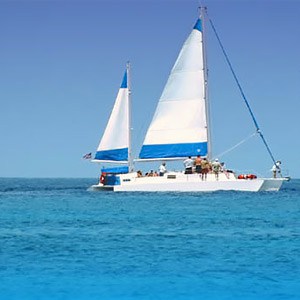Please Register / Login to take part in discussions about the Virgin Islands.
Dear islanders
Below is my first article in english - It has not been read and corrected by an american (or other native english speaker).
Please ask me if you do not understand what I'm writing 🙂
Enjoy.
Schimmelmanns Palace
– also: The Odd Fellows or the Berckentinske Palace.
It’s not of much importance the old Danish possessions in the Caribbean has in the minds of people in Copenhagen. They’re rarely given a thought even though they may be assigned a paramount importance for the city as it was shaped and developed. A development wich can be seen in streets and roads today – especially when you look at the buildings in Copenhagen.
Not many buildings survived the fires in 1728 and 1795, but with a background in particular the high profits that were on sugar and refining it, there were large sums of money in town. Hence there were favorable conditions present in order to regenerate the city of ashes. But the buildings that can be directely linked til USVI did not die from fire but was killed by human hands. The money was already among people and made the rising of the city possible. Money that had it’s origin in the Caribbean. The city was developing rapidly due to the enterprising merchants and nobility. Their earnings was spend on building prominent houses and rebuilding many of those we can enjoy today.
The Odd Fellow Palace is no exception - many of the most wealthy and most powerful personalities came to this Palace to party and network.
The Palace was built between 1751-55 by C.A. Berckentin and renovated shortly after by its new owner: minister of finances, Heinrich Carl von Schimmelmann. He was invited to Copenhagen by the king himself to get hold of Denmarks finances.
Schimmelmann had a history of doing great bargains on European trade markets. He made good money from wars between European countries and may I add: some deception too.
When the Danish king assumed Schimmelmann as minister of finances another king wished that Schimmelmann would be put behind bars. The Danish king granted his colleage his wish. He paid the replacement of the entrance and decorated it with beautiful iron bars.
Even though Schimmelmann at the time of arrival was quite wealthy he did so well in Denmark and died as one of the wealthiest men in the last part of the 1700. Even the king borrowed money from him.He mastered all part of being a businessman of the time: wear as many hats you can to make your profit grow. His relationship to the king and nobility, wich he soon was a part, was strengthened by a large-scale rescue of the Danish economy, in which he guaranteed personally.
He made international bankers trust Danish economy so the necessary credits was possible. But Schimmelmann also got his share. Often he got his money unauthorised and free of tax – but at that time this seems as a normal part of practice.
With the impact he had on Danish economy and politics he worked his way into all parts of the community. His position allowed him to obtain exclusive rights on some merchandise that was shipped to the colonies. He bought his way into weapons industry. Weapons that was shipped to Africa and traded for slaves, Slaves that could be shipped to the Caribbean to work on sugar mills and produce sugar for European markets. The sugar was raw and lacked some further processing. But Schimmelmann had his own sugar refiney. He was privileged by the king and because of all of his connections his income rose to dizzying heights.
His enterprise has influenced most of Copenhagen. Trace of his whereabouts can be seen everywhere - not least among those who consorted him and also earned good money. His investment created jobs and meant taxes for the king. In this way the city benefitted from Schimmelmann - and large parts of the basis of his earnings came from the Caribbean.
The buildings we left behind in the Caribbean still bears a strong Danish influence. Bricks, Danish blacksmith work and not least a striking architectural similarity with warehouses and corporate buildings that were built in Copenhagen in 1700. Roads and cadastres bears names familiar to Danish – names that causes pronunciation difficulties to the current residents.
Odd Fellow Palace escaped the fire in 1795 and mostly also the British bombardment in the early 1800's. But the fire that took hold on the buildings in 1992 got the better of the palace and the garden, wich later had been converted into a concert hall. In 1992 the country lacked no money and the palace was rebuilt to almost every detail. Concert hall acoustics could not be re-established and the mansion got back its garden
Schimmelmann would not have hesitated to restore the premises after a fire. Many of the other contemporary enterprising businessmen would also have paid what was necessary. Because: if you are a businessman you need a place to stay. A place that shows who you are, where you came from and what you were capable of. And the money to show this came from the lucrative business it was to trade on the Caribbean.
The Danish fort on the St. Thomas was founded in 1671 and rebuilt and when needed. Today there are some adjacent buildings, a firehouse, but our old fort is in closed for renovation. It houses a museum that shows the islands' history- including parts of our history. But the restoration was scheduled to be completed in summer 2006 but are stalled due to lack of money.
The fort is one of the relics we have in the Caribbean wich can tell us about the history that are surrounding us in Copenhagen. A story that can be seen every day in the alleys and streets - where we walk rapidly from place to place. Little are we aware that our city was founded by money earned far from our own fields – on the sugar fields in the Caribbean. Rarely do we link the prosperity we gained from the colonial engagements to the monumental buildings that surrounds us.
Odd Fellows is not idiosyncratic. It's a building that was a gathering point for people who had power and money and was seeking more of both. Their businesses and money spilled over large parts of Copenhagen. Either through new buildings, but also when these businessmen rebuild the existing houses. Warehouses, plants and small backyard houses are in many a ways connected to our colonies in the Caribbean.
If you like I’ll do more articles in English I’ll do stories of buildings, people and enterprising consortia whose history can be traced to the Caribbean. The money was not only from just this one overseas colony, but was part of a web of transactions with both Danish and foreign actors.
With all due respect you seriously need the assistance of both an English translator and local historian. 1992?
I'm absoluty aware of my english skills. Point taken.
Yes - I need the local knowledge, thats why I'm planning one moere stay 🙂
1992 is the year that Schimmelmanns palace in Copenhagen burned.
Your article provides an interesting perspective about a time and place that most people don't know about, unless they have purposely studied VI history. I am assuming that you translated it from Danish? The original sentence structure is apparently very different from modern English and the first three paragraphs were read with great effort. From the fourth paragraph to the end, the prose was much easier to read and understand. The only consistent spelling error was wich, when it should be which.
One aspect of the story that is note ably missing is any mention that the Danish wealth created by the sugar trade was only possible because of thousands of African slave laborers who were forced to work as captives. I learned when visiting St John last year, that when the slaves finally revolted against the oppressive Danish sugar barons, economical production of sugar became impossible, and the riches of sugar trade collapsed. I think any discussion of the great wealth created and enjoyed by Danes through the production of sugar should always mention that slave labor made it possible. I'm just sayin'
hansherlighed wrote:
I'm absoluty aware of my english skills. Point taken.Yes - I need the local knowledge, thats why I'm planning one moere stay 🙂
1992 is the year that Schimmelmanns palace in Copenhagen burned.
Thanks for the clarification appropos the Schimmelmanns palace in København which wasn't clear.
Have you visited the Danish Cemetery on St Thomas, have you knowledge of the Danish Cemetery Restoration Fund project, have you visited the Danish cemeteries in Frederiksted and Christiansted on St Croix, the old gravesites on St John? Have you been in touch with the St Thomas Historical Trust, have you researched the archives of the Enid Baa library here?
I applaud your desire to document but it will surely take way more than one more visit here to really understand the history of this island.
I enjoyed reading your article very much and appreciate your willingness to translate to English in an effort to share what you have learned thus far. I had no difficulty in understanding what you were trying to say and appreciate your effort very much. I encourage you to continue your course of learning and sharing in the manner which you write. Again, I for one enjoyed it very much! Cheers!
Dear Islanders
@ Jim and Mary
Thanks for showing and telling what is working and what is not working in the article. The article is written in Danish and translated. I sure need a proof reader who can correct future articles. If you know someone who could be interested in a joint venture I’d gladly go into such kind of co-work.
Perhaps an island magazine would be interesting in buyin’ some of the articles for printing?
The aspect of slaves are deliberately not in these articles. This due to the risk of having to deal with the moral aspect of slavery. I wrote the articles and was sure that all readers knew about the danes (and everyone else – including freed black slaves) having slaves as labour and that the wealth was made from this labour. I wanted to tell the story about the money rather than the story of the slaves.
But I do agree: slaves deserve to be recognised and the sixth article is also ‘dedicated’ to tell that all this could not have been done without the slaves and their hard work.
You are right about the sugar production not being profitable when slave labour was not at hand anymore. The second article tells this story.
@ STTResident
Thanks for the hints on where to go when I do my research tour. Please feel free to post further tips that can make my research more efficient.
@ Debfishes
Thanks for the encouragement = I will surely share my knowledge which (thanks J&M…) grows every day. I’ll try share in a better English next time – hopefully I’ve found myself someone who can correct my language by then.
For now there’s five other article ready for translation but I’m not going to spam you 🙂


